The insurance industry has always been about managing risk and providing security. However, as we move into 2025, the sector is undergoing an unprecedented digital transformation. Once reliant on manual processes and paper trails, insurance companies are now embracing new technologies that are redefining the way they operate. The shift isn’t just about efficiency, it’s about survival in an increasingly competitive market. With the advent of artificial intelligence (AI), automation, and a greater focus on customer experience, insurers are leveraging these innovations to enhance services, cut costs, and provide better coverage to their clients.
Editor’s Choice: Key Transformation Milestones
- Insurance technology spending in the US and UK is projected to grow by 8% in 2025, reflecting increased investments in AI and digital platforms.
- 76% of US insurance executives have implemented generative AI capabilities in one or more business functions, with 82% adoption in life and annuity insurers and 70% in property and casualty insurers.
- The global digital insurance platform market is estimated at $148.15 billion in 2025, projected to reach $255.43 billion by 2030, growing at a CAGR of 11.51%.
- Global spending on digital transformation (DX) is expected to hit $3.9 trillion by 2027, with a CAGR of 16.2% from 2022 to 2027.
- 35% of organizations identified improving customer experience and engagement as a primary goal of their digital transformation plans.
- 90% of organizations are undergoing digital transformation, reflecting their critical role in modern business strategy.
Key Insights on Barriers to Digital Transformation
- CEO or the board of directors are seen as the top blockers of digital transformation, accounting for 23.87% of the perceived resistance.
- Senior executive teams (excluding the CEO) also contribute significantly, with 20.65% citing them as a barrier.
- Interestingly, 20.65% of respondents believe no one is holding back digital initiatives, suggesting internal readiness in some organizations.
- Department heads make up 16.77% of the resistance, highlighting the role of mid-level leadership in transformation efforts.
- Middle managers account for 11.61%, showing they are less frequently perceived as a major hurdle.
- Only 6.45% of respondents see line employees as obstructing digital transformation, indicating that resistance is mostly from upper management.
These insights suggest that the biggest challenges to digital transformation stem from leadership levels, not operational teams.
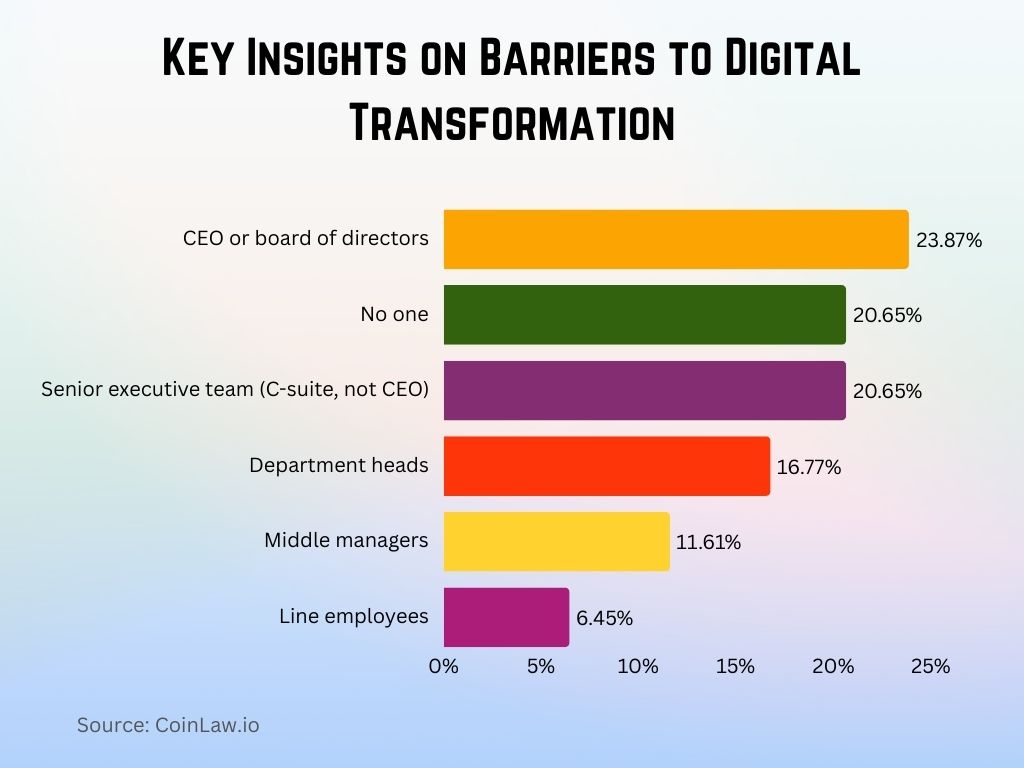
Core System Modernization and Legacy System Challenges
- 68% of insurance companies are upgrading their core systems to cloud-based platforms, enhancing agility and speed to market.
- Up to 70% of insurers’ annual IT budgets are consumed by maintaining legacy systems, underscoring the financial burden of outdated technology.
- 41% of CIOs report that legacy systems are the main barrier to tech success, hindering digital transformation efforts.
- Modern policy administration systems have enabled insurers to cut operational costs by 40–60% within the first year of implementation.
- 67% of insurance executives consider API strategy a critical component of their digital transformation roadmap, facilitating integration and innovation.
- 71% of insurance executives believe that cloud investments will directly impact their firm’s competitive advantage, emphasizing the strategic importance of cloud adoption.
- 41% increase in policy IT costs is observed when processed on legacy platforms, highlighting the inefficiencies of outdated systems.
Digital Transformation Market Growth Outlook
- The global digital transformation market is projected to grow from $1,755.44 billion in 2024 to $4,416.39 billion by 2029.
- In 2025, the market size will reach $2,116.91 billion, reflecting strong momentum.
- The market is expected to expand at a CAGR of 20.2% during the forecast period.
This growth highlights the increasing adoption of digital technologies across industries globally.

Role of AI, IoT, and Automation in Insurance
- 60% of insurers have adopted AI-driven underwriting tools, enhancing accuracy and efficiency in risk assessment.
- IoT devices are projected to generate $76.73 billion in insurance-related data by 2029, providing deeper insights for risk management.
- 80% of auto insurers utilize telematics to gather real-time driving data, enabling personalized premiums based on behavior.
- Automation has reduced claims processing time by 50%, allowing insurers to settle claims within hours instead of days.
- AI-powered fraud detection systems have decreased fraudulent claims by 30%, saving the global insurance industry billions annually.
- Smart contracts are increasingly popular, with 22% of insurers adopting them to streamline policy management and automate claims.
- By 2025, it is estimated that 70% of all customer service interactions in the insurance industry will be handled by AI chatbots, improving efficiency and customer satisfaction.
Cybersecurity and Data Protection Challenges
- 85% of insurers have experienced at least one cyberattack or data breach in the past year, highlighting the industry’s vulnerability.
- Global cyber insurance premiums are projected to reach $16.3 billion in 2025, reflecting the increasing demand for protection against cyber risks.
- Cyber insurance premiums are expected to grow by 15–20% annually, reaching approximately $23 billion by the end of 2026.
- Cybercrime costs are estimated to hit $10.5 trillion annually by 2025, emphasizing the need for enhanced cybersecurity measures.
- Data breaches in the finance and insurance sectors have an average cost of $5.9 million, underscoring the financial impact of cyber incidents.
- 75% of insurance companies are investing in advanced encryption technologies to safeguard customer data.
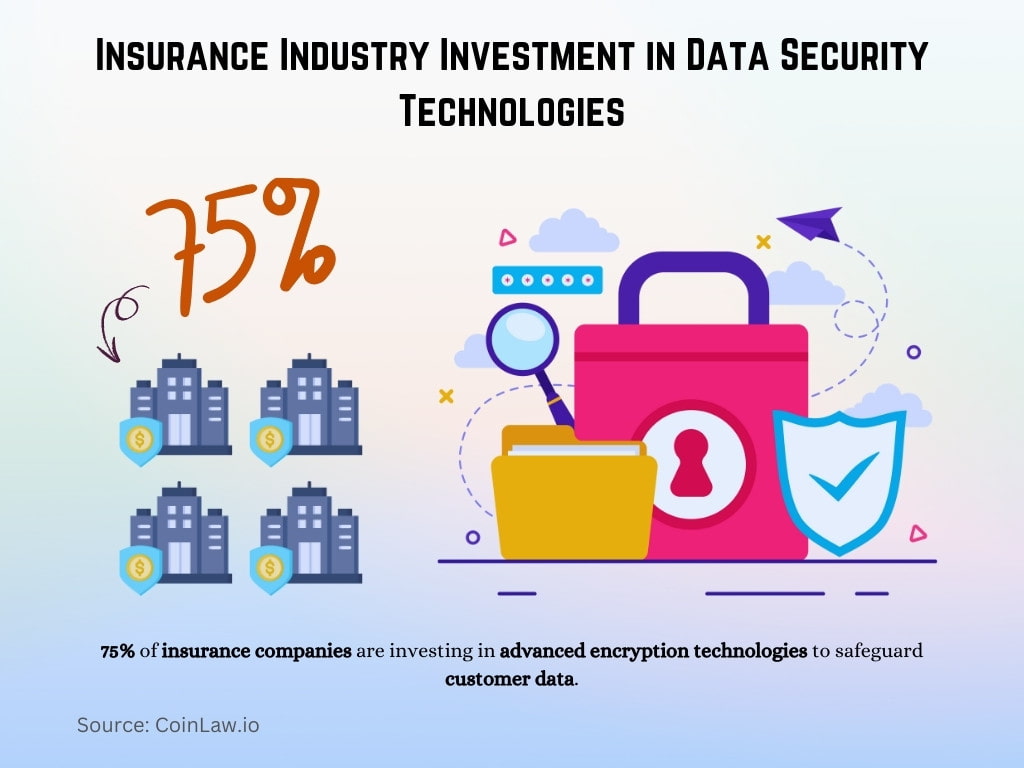
Embedded Insurance and New Distribution Channels
- Embedded insurance is projected to reach $210.9 billion in gross written premiums by 2025, growing at a CAGR of 35.14% toward $950.59 billion by 2030.
- 84% of younger car buyers (Millennials and Gen Z) prefer embedded auto insurance options at dealerships, enhancing loyalty and satisfaction.
- Embedded insurance is identified as the leading channel for future growth in personal lines, with 31.6% of industry respondents favoring it over direct-to-consumer and broker models.
- E-commerce platforms are experiencing a significant uptick in embedded insurance sales, driven by the escalating use of digital systems.
- Digital distribution channels, including mobile apps and online portals, are expected to account for 50% of new policy sales by 2025, reflecting a shift toward digital engagement.
- 70% of insurance companies are partnering with non-traditional distributors, such as ride-sharing apps and travel platforms, to offer embedded insurance solutions.
- Embedded life insurance products are projected to cover over 10 million individuals globally by the end of 2025, expanding protection to underserved markets.
How Digital Transformation Benefits Insurance Companies
- Enhances customer experience (CX) through innovation, offering personalized and faster services.
- Streamlines business operations, boosting overall efficiency and productivity.
- Reduces operational costs by automating manual tasks and improving resource management.
- Delivers data-driven insights, enabling smarter and more strategic decision-making.
- Increases agility and adaptability, helping insurers respond quickly to market and regulatory changes.
- Ensures smooth third-party partnerships, enhancing collaboration with external service providers and ecosystems.
These benefits highlight how digital transformation is reshaping the insurance industry for a more efficient, customer-centric, and competitive future.
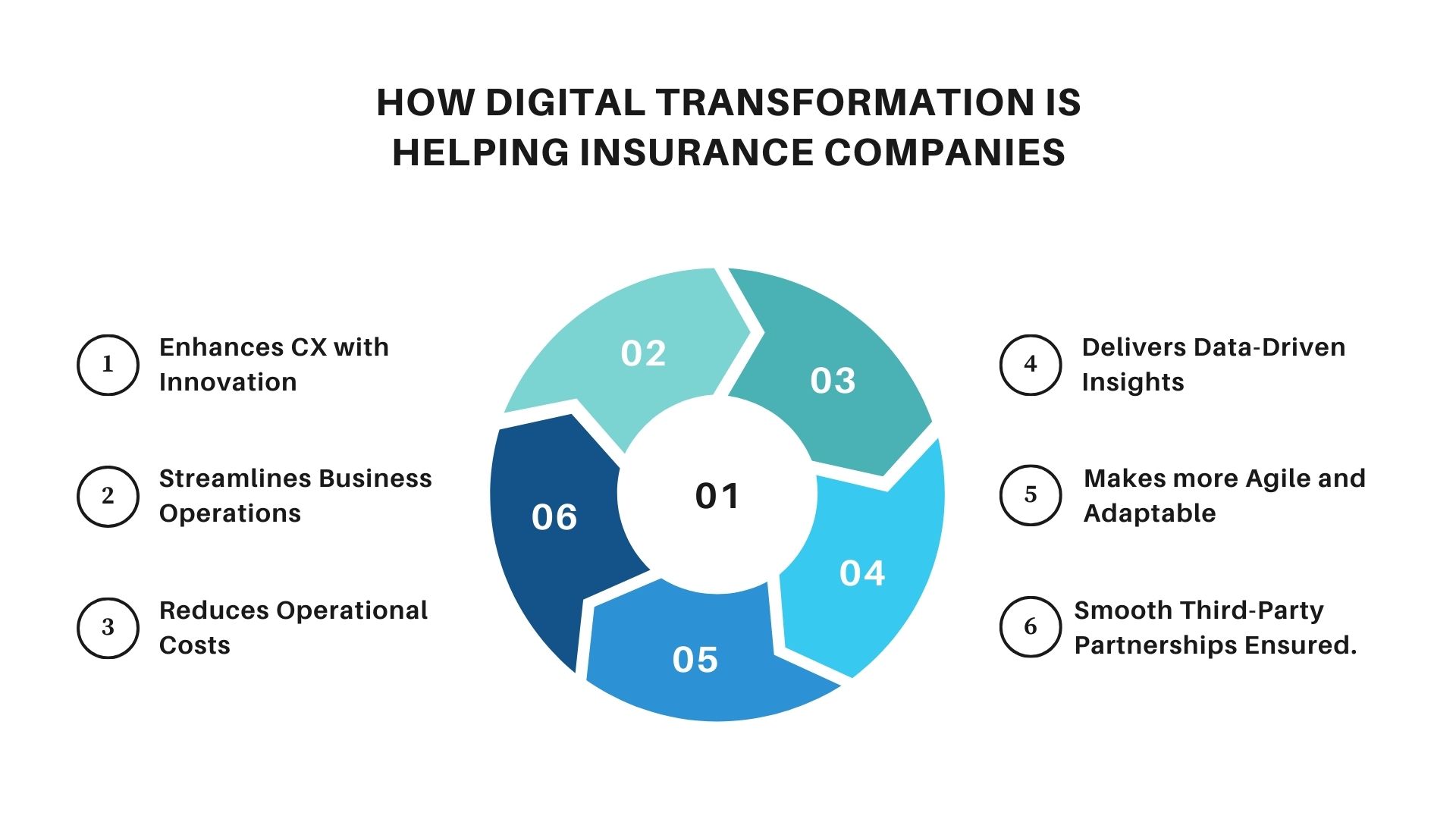
Insurance Digitisation Index: Country Rankings
- The United States leads with an 88% adoption rate of digital insurance platforms, driven by substantial investments in InsurTech and AI.
- Germany holds second place with 80% of insurers offering digital claim submissions and customer service via AI chatbots.
- Japan ranks third with a 77% adoption rate, heavily investing in IoT for risk assessment in home and auto insurance.
- The United Kingdom is fourth, with 75% of insurers having migrated to cloud-based platforms to enhance efficiency and scalability.
- France follows closely, with 70% of insurance companies offering fully digital policy management via mobile apps.
- India emerges as a strong player, ranking fifth with a 68% digitization rate, largely due to the rapid adoption of embedded insurance products.
- Australia rounds out the top six, with 65% of insurers integrating AI-driven fraud detection tools.
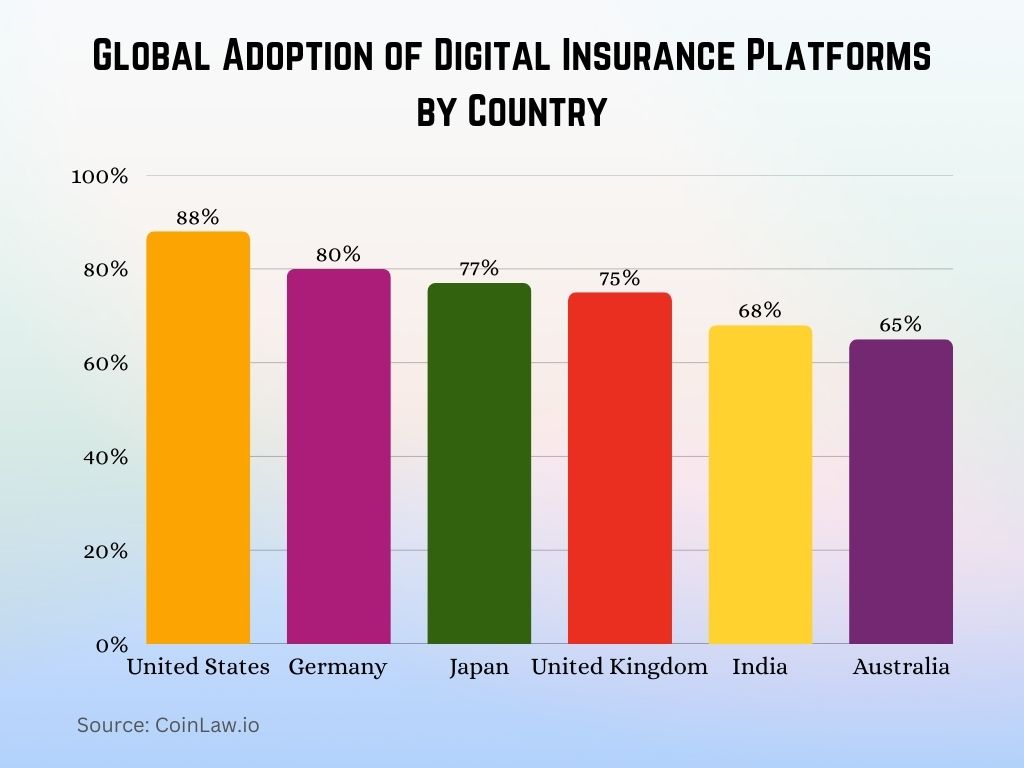
Customer Experience Takes Center Stage
- 95% of customer interactions in insurance are now handled by AI-powered systems, encompassing both voice and text channels.
- Digital claims processing has reduced average settlement times by 50%, enhancing customer satisfaction and operational efficiency.
- 82% of customers prefer using mobile apps for policy management, reflecting a significant shift towards digital self-service platforms.
- 70% of auto insurance customers favor usage-based policies, leveraging telematics to adjust premiums based on driving behavior.
- AI-powered chatbots have led to a 30% reduction in support call volumes, improving resolution times and customer experience.
- Personalized insurance products, enabled by AI and big data, have seen a 25% increase in customer satisfaction, highlighting the value of tailored offerings.
Impact of Climate Risk on Insurance Models
- Global insured losses from natural catastrophes are projected to reach $145 billion in 2025, continuing a long-term trend of 5–7% annual growth.
- Flood insurance premiums have increased by up to 18% in 2025, particularly in high-risk areas, due to escalating flood risks and regulatory adjustments.
- Wildfire-related claims in the U.S. have surged, with insured losses from the January 2025 California wildfires estimated between $28 billion and $35 billion, marking them as the most destructive in Los Angeles’ history.
- Insurers leveraging big data and AI have achieved a 10% improvement in underwriting accuracy for climate-related risks, enhancing risk assessment in high-risk zones.
- Parametric insurance adoption is on the rise, with the global market valued at $18.24 billion in 2025 and projected to grow at a CAGR of 11.7%, driven by the need for rapid, transparent payouts in the face of climate disasters.
- 58% of insurers are incorporating climate risk assessments into their long-term business strategies.
- Climate risk mitigation strategies are being used by 60% of insurers to adjust premiums and coverage, especially in regions prone to natural disasters.
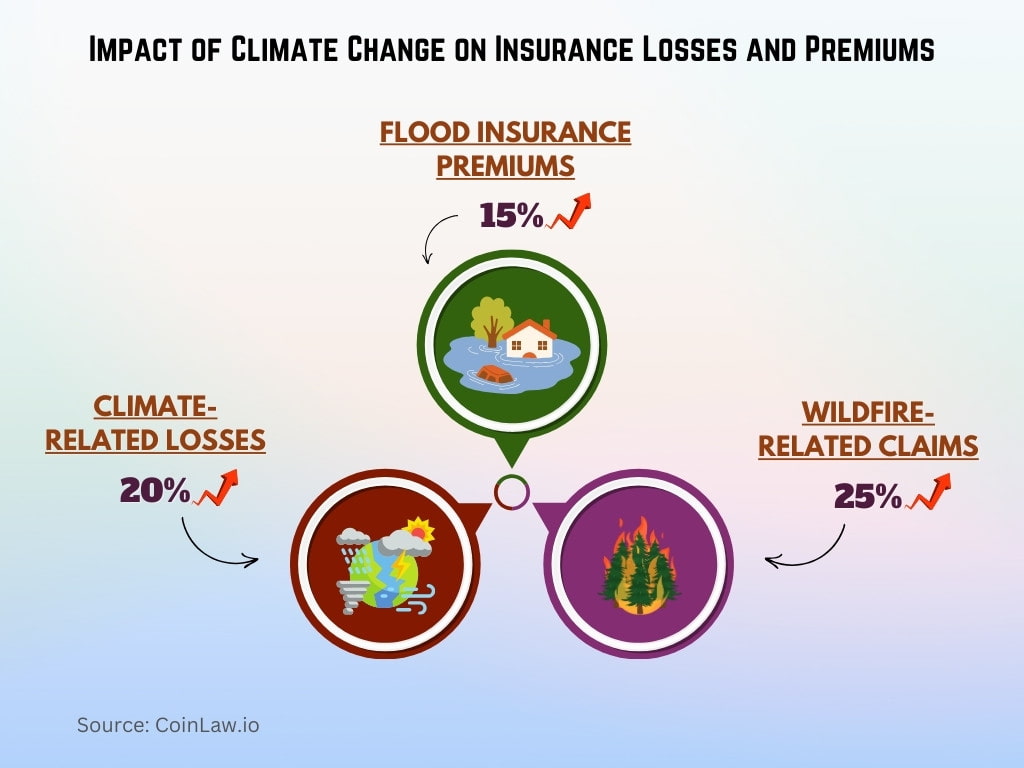
Recent Developments
The insurance industry is evolving rapidly, with new technologies, regulations, and market conditions shaping its future. Here are some of the most notable developments in 2025:
- AI Integration in Customer Communications: Allstate has implemented generative AI models, specifically OpenAI’s GPT, to compose the majority of emails from claims representatives. This approach has enhanced empathy in communications and improved customer satisfaction.
- Increased Digitalization Efforts: Approximately 63% of insurers plan to fully digitize by 2025, aiming to modernize customer experiences and boost operational efficiency.
- Rising Technology Investments: Forrester predicts an 8% increase in tech spending across the insurance industry in 2025, highlighting technology’s pivotal role in driving growth.
- Adoption of Low-Code/No-Code Platforms: The insurance sector’s IT spending is projected to reach $271 billion by 2025, with a significant focus on low-code/no-code tools to accelerate digital transitions.
- Blockchain Implementation: Companies like Lemonade and Etherisc are leveraging blockchain technology to offer innovative insurance solutions, such as parametric insurance and automated claims processing, enhancing efficiency and transparency.
These developments are redefining the insurance landscape, pushing both traditional and digital insurers to adapt quickly to remain competitive.
Conclusion
The insurance industry’s digital transformation is reshaping how insurers operate, engage with customers, and assess risks. Technologies such as AI, IoT, and blockchain are driving unprecedented efficiencies and cost savings, while cybersecurity and customer experience remain critical focuses. The rapid growth of embedded insurance and the integration of climate risk assessments highlight the industry’s adaptation to both technological advancements and global challenges. As we move forward, the continued digitization of insurance will be pivotal in determining the future success of the industry.
Hover or focus to see the definition of the term.


























































